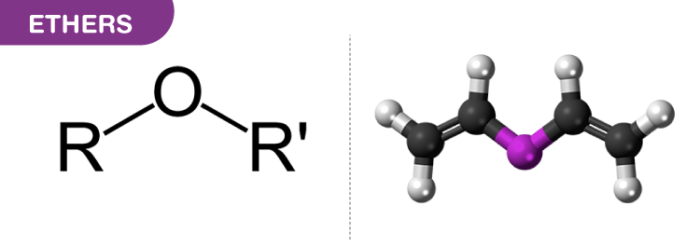What are Ethers?
Ethers can be defined as a class or a group of organic compounds comprising an oxygen atom, which is bonded to two same or different alkyl or aryl groups.
The general formula for ethers is R-O-R, where R represents an alkyl group.

How are Ethers classified?
Ethers can be generally classified into two categories, based on their attached substituent groups.
- Symmetrical ethers – Two identical groups attached to either side of an oxygen atom.
- Asymmetrical ethers – Two different groups attached to either side of an oxygen atom.
Earlier, most of the compounds with the same structural formula were known by different names depending on the regions where they were synthesized. This naming system was very trivial since it raised a lot of confusion. Finally, a common naming system enlisting standard rules was set up by IUPAC (The International Union for Pure and Applied Chemistry) for the naming of compounds. This method of naming is IUPAC naming or IUPAC nomenclature. Nomenclature of ethers revolves around two standard ways of naming:
- Common nomenclature
- IUPAC nomenclature
Rules underlying the Nomenclature of Ethers
- Common nomenclature of ethers follows the rule of naming different alkyl/aryl groups attached to the oxygen atom on either side in alphabetical order and finally adding the word ether to it. For example, CH3OC6H5 is named as Methyl phenyl ether.
- Ethers in which the oxygen atoms are attached to the same group on either side are named with the help of Greek numerical prefixes such as “di”. These ethers are named by adding “di” before the alkyl/aryl groups attached to the oxygen atom. For example, CH3OCH3 is named as dimethyl ether.
- IUPAC’s nomenclature of ethers follows different guidelines. According to IUPAC naming, a substituent group containing more carbon atoms is chosen as parent hydrocarbon. The other substituent group attached to the oxygen atom is named with a prefix “oxy”. For example, CH3OC2H5 is named as 1-methoxy ethane.
Frequently Asked Questions – FAQs
How do you name ethers in organic chemistry?
Popular names are given to basic ethers where the alkyl groups bound to the oxygen are called in alphabetical order followed by the term ‘ether.’ Under the IUPAC tag, the top left illustration indicates the generic name in blue. Many basic ethers are symmetrical in that they are the same as the two alkyl substituents.
Do ethers contain oxygen?
Ethers are a class of organic compounds containing a group of ethers. An ether group is an atom of oxygen bound to two alkyl or aryl groups. The ether’s oxygen is more electronegative than its carbon. The alpha hydrogens are also more acidic than in the normal chains of hydrocarbons.
How do you name ethers and epoxides?
A generic name will also be used for all ethers, and is also used interchangeably with the IUPAC name. The two groups flanking the O atom are called, alphabetized and the word “ether” is inserted to assemble the generic name. Simple epoxides are designated as oxirane derivatives.
Why are ethers unreactive?
For a number of organic compounds and reactions, ethers are commonly used as solvents, indicating that they themselves are relatively unreactive. The loss of the reactive O-H bond certainly affects the inert existence of the ethers relative to the alcohols.
Is ether still used?
Owing to its low cost and high medicinal index with reduced heart and respiratory distress, Ether is still used as an anaesthetic in some developed nations, but its volatile flammability has eliminated its use in most advanced nations.
For detailed discussions on the nomenclature of ethers, download BYJU’S – The Learning App.


Comments